Do you want to learn how to play music, read music? - This is not as difficult as you might think. In order to learn to read musical notes you only need to understand their structure and logic. The principle of their work is very simple, but it takes some time and practice.
Scale
Scale - this is the location of the sounds of the musical system in height, each sound of which is called the stage of the scale. The scale is divided into octaves (from lat. Octāva “eighth”), and the octave, in turn, is divided into the main stages of the scale, which are periodically repeated: do, re, mi, fa, salt, la, si, do .
Notes. Music camp. Musical notation
A note is a circle (painted over or not painted over), also depending on its duration it may have “ calm"(Vertical stick)," tails"And" ribs«.
 To record notes, use stave (or musician). This is a ruler on which notes and all other signs are placed. Each of the rulers, as well as the gaps between them, corresponds to one of the steps of the diatonic scale, that is, notes are recorded both on the lines and in the gaps between them. The lines are considered to be from the bottom up.
To record notes, use stave (or musician). This is a ruler on which notes and all other signs are placed. Each of the rulers, as well as the gaps between them, corresponds to one of the steps of the diatonic scale, that is, notes are recorded both on the lines and in the gaps between them. The lines are considered to be from the bottom up.
 It often happens that you need to use a higher note, but it does not fit on the lines of a musician. To solve this problem, use extension lines. They can be placed both from the bottom and from the top, their score is as follows: the top - from the first extension line up, the bottom - from the first down.
It often happens that you need to use a higher note, but it does not fit on the lines of a musician. To solve this problem, use extension lines. They can be placed both from the bottom and from the top, their score is as follows: the top - from the first extension line up, the bottom - from the first down.
 To separate the measures, a special
To separate the measures, a special
bar line
(more on the beat later).
 There is also double bar,
There is also double bar,
but it is used to separate certain musical fragments.
 Long measures are not very easy to read, therefore, to facilitate the reading of notes, there is dotted bar.
Long measures are not very easy to read, therefore, to facilitate the reading of notes, there is dotted bar.
Accolade It is intended for combining musical staves that are played simultaneously on one instrument.
it is intended in the same way as the accolade for combining musical staves, but only for different musical instruments.
The duration of notes is very important in music. Let's look at the types of durations.
Whole note - This is not a painted oval. Half - also not a painted oval, but it also has a calm, lasts exactly half of the full note. The fourth It looks the same as half, but already painted over, lasts 2 times the previous one. Eighth note - as the previous one, but a tail or an edge has already been added here (when grouping notes). Further durations are written according to the same principle as the eighth by adding tails. 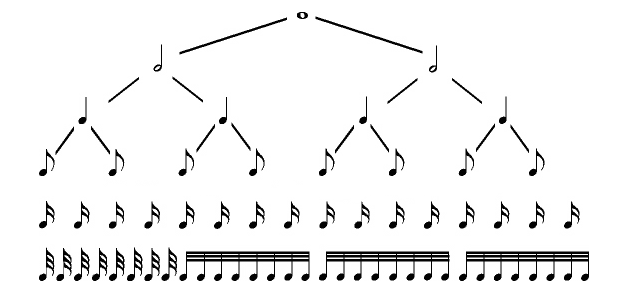
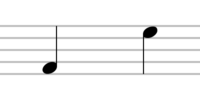
In monophonic melodies, calm notes may have different directions, depending on its altitude. If the notes are on the midline or higher, then the calms are directed down, if they are below the middle, then the calms look up. This is done only to make the notes on the musician look more compact.
Note: If the calm of the note is directed upwards, then it should be drawn starting from its right side, and if downward, then from the left side.

Ribs are used to group notes, to make them easier to read. By the way, they are not always horizontal, there are also vertical ones, depending on how convenient it is.
The signs of musical durations and pauses determine only the relation to each other of their durations at a certain speed of the game (pace). For example, if a whole note sounds 2 seconds, then a half - 1 second, or, when playing slower, a whole sounds 6 seconds, then a half - 3.
The keys
What are they for? The keys in musical notation determine the pitch of the notes. It is placed at the beginning of the musician so that the central element lies on the line from which the altitude positions of the remaining notes will be counted. There were many different keys in the story, which complicated the task of reading notes. But, fortunately, today only 5 keys use a musical notation (2 of them in very rare cases).
Treble clef (key Salt). It is placed on the second line (the center of the spiral should be directly on it) of the musical staff (we keep the score from the bottom up :-)), it indicates the pitch of the sound Salt The first octave on this line (approximately 392 Hz). This is the most commonly used key in musical notation.
Bass clef (key of the Fa). It determines the position of the notes. F Small octave (approximately 175 Hz). The bass clef is placed on the 4 lines of the stave.
Treble and bass clefs can be applied with a shift of one or two octaves up or down. To shift up one or two octaves, 8 or 15 above the key is written, down - just the numbers are written under the key. Sometimes a shift of one octave up is simply indicated by two note keys instead of one.
Neutral key - in the musical notation, this key play a special role, it is used to record various percussion or percussion instruments that do not have a certain height. One tool is considered to be a line or a gap between them.
And finally, the key before. It has 2 types: violaand tenor. Both of them are used quite rarely.
Alt key denotes a note before the first octave and is placed on the middle line of the musician. It is used when recording parts of viola, trombone and sometimes vocals.
Tenor key denotes the same as the alto, but is installed on the fourth line of the musician. It is used for bassoons, cellos, trombones and double basses. 
Most likely, you have a question “Why are there so many different keys in a note letter?”. The fact is that each musical instrument or voice has its own frequency range of sounds (low, medium or high) and use different keys to avoid unnecessary additional lines on the musical instrument and to simplify the reading of notes in musical notation.
Signs to increase the duration of notes.
In addition to the main durations, a musical notation includes additional signs for prolonging notes and pauses.
First sign - dot. It extends the note by half of its main duration. Two points extend 3/4 of the value,
three - on 7/8, etc.
League- another sign of prolongation of sound, its essence lies in the fact that it combines the duration of notes and they are performed as one note with a duration, equal amount durations of the combined notes. In a note writing, it is also used to record notes whose size is more than one measure.
- A very interesting sign for extending notes. Why? Because the duration of the note is determined at your discretion, you can extend as much as you want 😉
Quite often, a farm is used as a pause between parts of a play.
Pauses in music also play an important role, for example in creation. They, like notes, have their duration. 
These are the main types of pauses that are used in musical notation. There are two more pauses that are less commonly used.  . Its duration is already four whole notes.
. Its duration is already four whole notes.
 . A pause of two whole notes.
. A pause of two whole notes.
Important! Pauses can also be extended with points and fermats, with the exception of the league!
Alteration Signs
If you read an article about sound, then you probably remember that there are only five signs of alteration:
Sharp - increase in semitone,
Double Sharp - increase by 2 semitones or by 1 tone,
Flat - decrease by half a tone,
Double flat - decrease by one tone,
AND natural - a sign that cancels the rise and fall.
Musical notation defines two types of statement of signs of alteration, namely before the key and by chance.

Musical notation. Alteration
Key characters set by the group right after the key and remain valid in all octaves until the end of the play or change of signs.
Random characters on the contrary, they are set only in front of the note, which must be altered and valid only in one octave and only until the end of the measure in which they are, unless, of course, canceled by other signs of alteration.
Remember these signs, in fact, is not at all difficult. A note or musical notation is not so difficult. The practice itself poses a greater task, to learn to read music quickly and, at the same time, to play well is much more difficult than theory. Exercise regularly and very soon you will begin to feel the music, learn to hear every voice in it 😉
Lesson 2 (musical notation, rhythm and meter)
Musical notation.
A note writing is a historically established system for recording sounds with special characters - notes (note, Latin word, translated means a sign).
A note sign is a circle - empty or shaded.
To indicate different durations of sounds, vertical sticks are added to the circles, which are called "calm", "tails" and "ribs" - straight lines for linking short durations into groups.
To determine the pitch, the notes are placed on a stave (stave). consisting of five parallel lines representing together one musical note string. The lines are counted from below. At the beginning of the stave, a vertical musical line is placed connecting all five lines. It is called the initial line; in single-line recording, the initial line may not be set.
Notes are written on the stave - on the lines and between the lines, that is, in the intervals:
above and below the rulers, and also (when the notes are too high or low) - on short additional rulers, which are attached from the bottom or top to the stave.
Additional rulers are counted: the upper ones are up from the first additional line, and the lower ones are down.

Duration of sounds.
The whole note is an unshaded circle (oval), the half is the same, but the calm is added, the fourth is the same as the half, but the oval is already shaded, the eighth is the previous one, with the addition of a ponytail or rib (if the notes are grouped), the sixteenth is the same the eighth, but its tail (or edge) is represented as a double. Further, according to the same principle, smaller durations are written: thirty-second, sixty-fourth ... see. Figure. 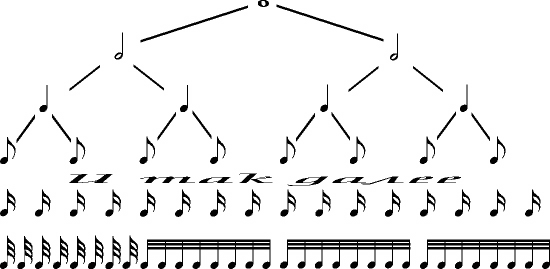
Ribs have the same meaning as ponytails, and are used to meaningfully and logically combine short notes into groups, so as not to clutter up the record with numerous squiggles and facilitate a quick reading of notes.
The keys.
Each line of the musical staff conditionally assigned a certain pitch. But since there are many different instruments in the world that play too different high-altitude areas, several different “reference points” of height are used in music. This is done using a conditional sign called a key.
The key is placed at the beginning of the stave so that the line from which the count is taken in this key intersects the key at its nodal point.
The key assigns to the note standing on this line an absolutely exact pitch (frequency of sound and its name), from which you can get the heights and names of all other sounds on the stave.
Historically, there were about a dozen different keys distributed, which is why mastering musical notation was a rather laborious affair. Currently, only two different keys are used; and two more - only in specific situations.
Treble clef (key Salt). On the second line it denotes the pitch of the salt of the first octave. The nodal point of the key is located in the center of its spiral, that is, it should be “wound” on the second line of the musician.
Bass (key Fa). Indicates the pitch of the small octave fa on the fourth line. Two bold points in his image should cover the fourth line.
These are the two most commonly used keys. To write notes for some instruments, two more keys remain in the application, or rather, one, but in two versions.
Key Up to two types: alto and tenor:
The tenor key denotes the pitch to the first octave on the fourth line.
The alto key is used for viola and trombone. Tenor key - for cello, bassoon and trombone. Its nodal point is clearly visible - this is the center of its symmetry. The cello performs works in three keys: bass, tenor and violin.


Signs of alteration.
Raising and lowering the main notes is called alteration. There are five signs of alteration: sharp, double sharp, flat, double flat and bacar. They are written as follows:

The action of the signs of alteration on the height of notes is: Sharp - Increases the pitch of a note by a half tone. Flat - lowers by the same amount. Double Sharp- increases by a whole tone. Double flat - lowers by the same amount. Natural - cancels the previous character on the same line. The note becomes clear.
In addition to the main durations with which we have already become acquainted, in the letter of writing there are also signs that increase the duration.
These include:
but)
A point that increases this duration by half; it is placed on the right at the head of the note:
b) League, an arched line connecting the adjacent musical notes of the same height:

(the duration of these durations will be equal to their sum)
in) Fermata, a sign for an indefinitely strong increase in duration. For some reason, many are smiling when meeting this sign. Yes, indeed, the duration of the notes must be increased, but all this is done within reasonable limits. And then you can increase it like that: "... and then I'll play tomorrow." Fermata is a small semicircle with a point in the middle of the bend:

Pauses
A break in sound is called a pause. Duration of pauses is measured by the same durations as notes:

To increase the duration of pauses, points and fermats are used, as well as for notes. Their meaning in this case is the same. Only here leagues for pauses do not apply. If necessary, you can set several pauses in a row, and do not care about anything else.
Bar line. Tact.
Bar line - This is a small vertical line, which is written across the musician. A note following a bar usually has an accent. A recording of a piece of music between two adjacent time lines is called a measure. Beats divide musical pieces into equal time and stress distribution segments. This makes it easy to read notes and perform musical works. 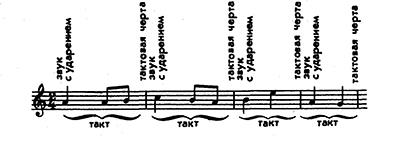
Score. Unit of account, or beat share.
To properly play notes or to pause various durations, use the account.
The score (musical size) is indicated by two digits that are written after the key at the beginning of the piece of music: the top digit is the number of note durations per measure taken as a unit of time (counting); the bottom digit is the name of these durations (integer, half, quarter, eighth). For example:

Rhythm.
The rhythm is the ratio of the durations of sounds in their sequence. Not too abstruse? Let's try it easier. In music, an alternation of durations occurs. One note sounds so much, say, time, and the other longer (less). As a result, various time relationships are created between them. Combining in various variations, the durations of sounds form rhythmic groups (figures), of which, in turn, add up the general rhythmic pattern of a musical work.
Durations are used in music: 1) basic (even division), we already know about them, these are whole, half, quarters, eighths, etc. and 2) durations arising from the arbitrary (conditional) division of the main durations into any number equal parts. Among them are: a) Triol, formed by dividing the main duration into three equal parts instead of two. b) Quintol - into five parts. in) Sextol - in six parts. d) Septol - into seven parts. 
That is, three eighths in the triol group in total occupy the same time as one quarter, the same quintole, etc. Of course, notes may not necessarily be the same height as in this example.
There is a simple device that helps the musician to maintain the right pace at the stage of learning a new play. This device is called a "metronome." This is a simple mechanism of two or three gears, a spring and a long pendulum with a moving weight, but over the past decades, equally uncomplicated options on the electronic principle have spread: two or three transistors, a socket and a knob-regulator. All that this device can do is make clear loud clicks with a very precisely maintained frequency. Moving the weight on the pendulum or turning the knob, we get the desired frequency - and the metronome clicks “until blue”, keeping the pace and not allowing you to relax while playing the instrument. These clicks - this is the "meter". In other words, the “meter” is the very course of time. But one should not liken it to the very clicks of a metronome. When you finish work on the work, you will remove the metronome and go on stage without it. Nevertheless, during the performance of the work, the meter ripple continues to exist. That is, a meter is a ripple of time, but a ripple is abstract, which may not be expressed in any way in sounds. The rhythm can consist of eighths, of triplets, of pauses, points and leagues, it can change every minute during one piece, it can split durations into 2, 3 and so on. It can even be intertwined in several layers at the same time. But a meter is always the same pulse, it doesn’t break up, it is indifferent to sounding music, it is implacable. It can not be heard, but all the sounds are subordinate to him to one.
Knowledge musical notation It is necessary for both a professional and a beginner who wants to master various types of guitars. Because knowing the basics of how to build music will help in learning, and you will achieve results faster.
The material in this article is an additional lesson, since only the musical staff is mentioned in the guitar tutorial, and the musical notation is not affected.
If you know the notes, it will be easier for you to learn the work, because only the notes can convey all the rules of the game that the author intended. In order to be able to read, you must first learn the letters, and so the notes are the same letters, only in music.
And then, there is nothing complicated in musical notation, and its development does not require much time. And if in the future you plan to take up writing arrangements, then you can’t do without musical notation.
A more simplified record of the melody in music is tablature, but it will be described in another article.
Musical note and stave
So, let's start the study of musical notation and notes for the guitar, the concept stave.
Notes and stave.
 A note mill consists of five horizontal rulers. The bottom line is considered the first.
A note mill consists of five horizontal rulers. The bottom line is considered the first. 
There are notes on the stave. Graphically - a note consists of a head, calm and flag. In the recording, the head is always present, but the calm and flag may not be.
In addition to notes on musical lines (stave) can be located various signs (signs of alliteration). The signs themselves do not represent any sound, but carry important information on how to play the notes.
Also, pauses can be placed on the stave. If notes are a graphic image of a sound, then pauses are the absence of sound. Pauses can be different, but more on that later.
How notes are arranged on musical lines.
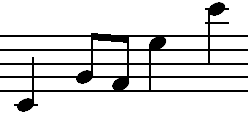 The note head is located on one of the lines of the musical staff or between the lines or on the additional line (a short line above or below the main lines).
The note head is located on one of the lines of the musical staff or between the lines or on the additional line (a short line above or below the main lines).
The calm of the note is directed up if the head of the note is located below the center ruler, or down if the head is on the third ruler or above it. Calm is in all notes except the whole.
If the calm is directed down, then it is written on the left side of the head of the note, if up, then on the right. It doesn’t matter where the calm is directed, it is important on which line the note head is located.
Sheet music for guitar
Record notes for guitar at the stave.
At the beginning of each musical staff, a musical key for notes for the guitar is written, to indicate notes played on the guitar, a treble clef is written.
The acoustic guitar range covers several octaves: small octave, first octave, third octave. Octaves are made up of notes.
The figure shows the sequence of notes that an acoustic guitar covers. Starting with the sixth open string and ending with the first string on the twelfth fret. The decoding of the notes is presented below the musical notation, and you can understand which guitar string and on which fret will produce a specific note. 
The concept of the duration of notes.
All notes for the guitar are divided by the duration of the sound. There are whole, half, fourth, eighth, sixteenth notes. Less often - thirty-second, sixty-fourth notes. They can be seen in the figure. 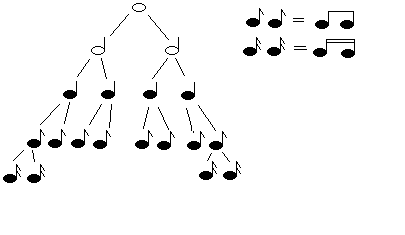
Now let's see how they differ.
To understand how long a whole note sounds, let's count it at a calm pace.
So, the whole note is one, and, two, and, three, and, four, and.
A half note is two times shorter - one, and, two, and.
The fourth is two times shorter than half - one, and.
The eighth is two times shorter than the fourth - one.
The sixteenth is two times shorter than the eighth, and so on.
Eighth notes have one flag added to the calm, sixteenths have two flags, thirty-second have three, and so on. If two adjacent notes have the same duration, then they are joined by an edge.
For example, two eighth notes are joined by one edge (since the eighth note has one flag). Two sixteen with two ribs, and so on.
Note with dot.

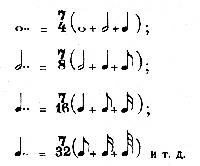 If a dot is placed after a note, then the duration of this note increases by half of that note. If two points are set, then the duration increases by half of this note plus a quarter of this note.
If a dot is placed after a note, then the duration of this note increases by half of that note. If two points are set, then the duration increases by half of this note plus a quarter of this note.
Pauses
A pause is a break in sound. Pauses, like notes, have a different duration.
 A whole pause - one, and, two, and, three, and, four, and.
A whole pause - one, and, two, and, three, and, four, and.
Half pause - one, and, two, and. And so on.
Starting with the eighth, pauses have flags (like similar notes), that is, the eighth has one flag, the sixteenth has two flags, and so on.
Signs of alliteration.
Alliteration signs are signs that affect the properties of a note. If the signs are near the key, then they are valid throughout the work, if in another place, then their effect extends to the beat.

Signs of alliteration include:
Flat - lowering the note by half a half,
Double - flat - lowering the notes per tone,
Sharp - note increase by half a tone,
Double - sharp - increase the note per tone,
Bekar - cancels the action of sharp and flat,
Reprise - repeating a measure once
Revolta - repeating a measure four times,
Lantern - cancel revolutions.
Here is the arrangement of the notes on the fretboard of an acoustic guitar.
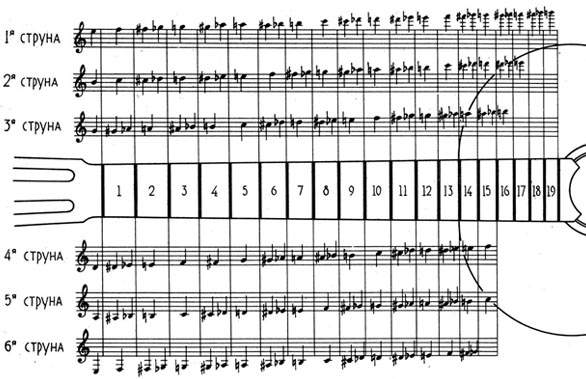
These are the basic concepts of musical notation. They will be enough for you to play the acoustic guitar.
In the near future, the material will be replenished.
I even understand why people write music without any interest in notes. There are many such arrangers. This is a ubiquitous problem, on any music portals there are people who write notes at random ... no idea chords, harmony and musical notation. They say: "Nooo, notes are not for me." The whole problem is that harmony is very good. complicated science. Many children graduate from music school without a clear understanding of harmony. Thick tutorials, too, will not save the situation - because they scare away with their texts, everything seems very complicated.
But in fact, everything is much easier! You can get acquainted with musical harmony and learn how to play chords after reading one of my lessons. Enough to read this lesson to write music at the level of world hits! Indeed, if you look into the hit parade, there are compositions composed of 3-4 chords. Nothing complicated.
Musical notation - A science that teaches music writing. But I think if you write electronic computer music then a musical staff, scores, treble clef, ... - all this is not necessary ... FL Studio does not use a musical staff and musical notation in its classical form, everything is much easier there!
In this lesson I will write how to achieve harmony in music, I’ll write in simple, understandable words, with understandable pictures for an example - this will be our musical notation :)
Lesson Objective: To show successful combinations of chords. Musical harmony is easy!
Now we will learn harmony in 3 steps :)
Step 1. The first thing you need to get acquainted with is the concepts of Minor and Major. Those. we only need to understand how they are designated.
A - this is the A major.
Am - this is an A minor chord.
B - this is C major.
Bm - this is the B minor.
C - C major
Cm - C minor
In Fruity Loops, they will look like this (see picture below)
If you notice, u minor average note is slightly lower than that of major - and this is the only difference.
For the curious, I’ll say the designation of such an icon #
- this is a sharp (the same note, only a semitone higher).
But we will now learn harmony based on the A-minor key, which means that we won’t touch the black keys (and all sorts of sharps) (except for rare exceptions, more about this later).
Step 2.
Key in A minor uses only the white keys from the Piano-roll, so look at our first picture (Figure 1), which means
chord
A (A-Major) does not suit us - it uses the black C # key.
Chord Am (A-minor) uses only the white keys A, C, E - which means it fits.
Chords B and Bm do not fit at all, because they have the third note F # (black).
Chord FROM (C major) - suitable, all this can be seen from the picture.
In order not to suffer for a long time, I can say right away, here are the chords that we will use:
Am, C, Dm, Em, E, F, G.
Only 7 chords !!! :) God, how simple it is !!!
If you are a beginner, use only 6 chords: Am, C, Dm, Em, F, G (this is enough to write a hit with white keys! :))
All these chords use only the white keys in the piano-roll, but there is an exception ...
It's a chord E (E major) - it consists of notes of Mi, G sharp, C. (In piano-roll, these are notes: E G # B), but at the same time never use the note Salt (white key).
Why?
The mystery probably lies somewhere in the east ... Because it is in oriental music, Arabic music, Indian music - the tonality is slightly different from Western European, by one note. Try playing the E major chord on the keyboard, these are the notes: Mi, Fa, G sharp, A, C. See picture below.
100% you will feel some oriental motive!
Harmony training online lesson - the whole point on one page
And last 3rd step.
I'll write right away successful chord combinations, everything has been invented for a long time, and there is no need to reinvent the wheel.
Record yourself these successful chord sequences, and use them to write competent music.
Am-dm-em-am
Am-f-dm-em
Am-c-dm-g
Am-dm-c-g
Am-f-g-am
Am-g-f-em
Am-f-c-g
Am-am-dm-e
Am-f-dm-e
Am-am-f-e
Am-g-f-e
Am-f-c-e
Create your track from scratch.
And in club music everything is much more primitive, there is music for 2 chords and such combinations are popular:
Am-am-am-g
Am-am-am-e
Am-am-em-em
And this is far not all successful chord sequences. I wrote the most successful in my opinion.
Later, you can add to your list with your favorite chord combinations. But even these are enough to write a hundred musical hits)
Now we fix the material covered by a clear example in the pictures. For example me create harmony in chords Am-Dm-Em-Am (see figure).
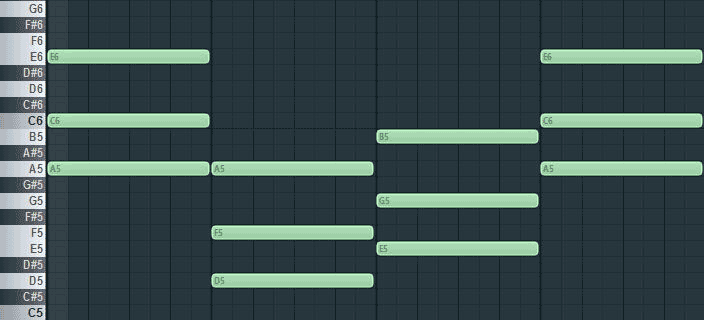
Everything is done right
chord Am - bottom note A5
chord Dm - bottom note D5
chord Em - bottom note E5
But it is not necessary to build chords so evenly.
If you want to avoid such sharp jumps of harmony up / down - you can make the transitions smoother. To do this, we will transfer a few notes an octave up (see the figure below).
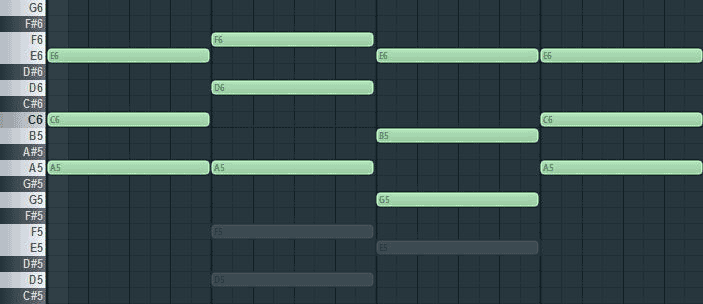
In the second Dm chord, we moved 2 notes up (an octave). From the fact that we transferred note D5 to D6, and note F5 to F6 - the chord has not changed, this is still the Dm (D minor) chord.
Those. it is important to understand that the combination of notes of Re-Fa-La is a D minor chord, but the combination of notes of Fa-La-Re or La-Re-Fa is also a D minor chord and it also sounds good and harmonious!
Download this FL track and you can hear how these chords sound. And see how they are built.
This lesson reveals basics of musical harmony and all on one page. Bookmark this page, it can still be useful to you if you forget something.
Write comments and you can also share links to your tracks created in this lesson ... and we will listen, evaluate and give advice.
How to learn notes?
Learning to read musical notation is not as difficult as it might seem at first glance. The main thing is to be patient and assiduous. There are only seven main notes, which means that it will take not so much time to assimilate them. On how to learn notes, read further in our article.
Music notation training
To learn notes, you will need
- Synthesizer or Piano;
- Notebook
- A simple pencil.
Instructions for teaching musical notation
- To get started, take the time to learn, relax and carefully study the keyboard layout on the piano or synthesizer. A closer look at the instrument reveals cyclically repeating sets of keys called “octaves”. Octave - these are the seven main notes that you have to master.
- Press the first white key of any octave “do”. Behind it on the right side is the note “re”, then “e”, “fa”, “salt”, “la”, “si”. After the note “si”, the octave ends and a new octave begins, again from the note “before”. To quickly memorize octave notes, play them several times and sing them out loud.
- With a detailed study of the tool, you can also find black keys. Between the notes “do” and “re” there is a black key - the note “do-sharp” or “re-flat”. Thus, the same note has two names. The names of the notes may change depending on the piece of music. By analogy, try to name the next three black keys yourself.
- Now it is time to use a music notebook in which lines of five horizontal stripes will be printed on blank white sheets. Draw a black circle under the bottom bar in the first line and cross it with a short horizontal line. You wrote the first note of the octave - “do.” The note “re” looks like a black circle, located directly below the bottom line of the line. Note “mi” - a circle that is applied over the bottom line of the line. The note “fa” is located between the bottom and the next lines. The note “salt” is located on the second from the bottom line of the musical line. Note “la” - by analogy to the level above “salt”. The note “si” is located on the third line. Higher along the lines, a new octave begins, again from the “to” note.
- Now we will learn to write “C sharp”. This note looks the same as the “before”. The only difference is the “sharp” icon right in front of the note, which looks very much like the grill on the phone keyboard. To write the note “do-flat”, before the note “do” you should put the sign “flat”, which looks like the Latin letter b. To fix the material, alternately assign icons to each note and simultaneously play them on the instrument.
- Now the last and key exercise. Having picked up a notebook, write down any notes on free lines. Then go to the piano or synthesizer and try to play them. When you can quickly, without hesitation, navigate the notes and play them on a musical instrument, you can safely say that you learned musical notation. The main thing is to practice a lot and hard.
A few more tips to help you better navigate the notes you will find in our article -


